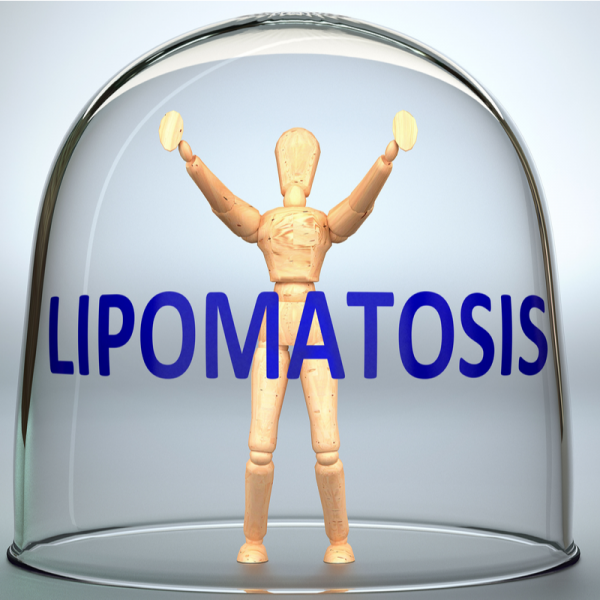
What is lipomatosis?
Lipomatosis is a diffuse increase in fatty tissue (fatty tissue hyperplasia), which can occur mainly on the hips and around the heart (lipomatosis cordis). The disease is a rare, benign skin disorder that usually occurs due to genetic factors. Lipomatosis is characterised by the clinical appearance of many painless, encapsulated lipomas that occur in the subcutaneous fat tissue of the trunk and extremities.
What types of lipomatosis are distinguished?
In the medical literature, the following four types of lipomatosis are distinguished from each other, which mainly determine the localisation of the disease:
- Type I: affects the neck area (Madelung syndrome, localised),
- Type II: affects the shoulder girdle (pseudoathletic type),
- Type III: affects the pelvic girdle (gynaecoid type),
- Type IV: affects the abdomen
Furthermore, lipomatosis can be divided into the following three rather rare clinical pictures:
- the benign symmetric lipomatosis, named after its discoverer Launois-Bensaude,
- familial multiple lipomatosis: a very rare disease characterised by its numerous, encapsulated benign lipomas located in the subcutaneous fatty tissue. The disease usually appears in the third decade of life, but in some cases it may develop during childhood or adolescence. Familial multiple lipomatosis mainly affects the neck, trunk and limbs.
- lipomatosis dolorosa (Dercum's disease)
How does lipomatosis develop and what causes can it be attributed to?
In lipomatosis, fat cells multiply uncontrollably beyond normal levels. Lipomatosis can appear asymmetrically on different parts of the body, but it can also appear symmetrically.
The reasons for the development of lipomatosis are not yet known. However, research assumes that the risk of developing lipomatosis is increased by diabetes, liver damage, lung carcinomas or polyneuropathies. In addition, a malfunction of the thyroid gland and changes in uric acid levels caused by gout can promote lipomatosis. Doctors also assume that the so-called Kaposi's sarcoma, which occurs particularly frequently in AIDS patients, is involved in the development of lipomatosis.
If it is a case of familial multiple lipomatosis, genetic causes can also contribute to the development of the disease, although the underlying genetic defect is not yet known to medical experts.
How can lipomas be prevented?
So far, there are no suitable preventive measures to prevent the development of a lipoma. If there is a suspicion of familial multiple lipomatosis, human genetic counselling can help in individual cases.
What are the symptoms of lipomatosis?
Lipomatosis is usually painless. If it is a particularly large lipomatosis or if it is located on parts of the body that restrict mobility, the lipomatosis can be perceived as particularly disturbing. In addition, lipomatosis affects the aesthetic appearance, which can lead to considerable psychological problems for those affected.
How is lipomatosis diagnosed?
After taking a medical history, the patient is clinically examined. For this purpose, imaging procedures such as a computer tomography (CT) or a magnetic resonance imaging (MRI) can be used. The CT or MRI scans can show how far the lipoma has spread.
How is lipomatosis treated?
In most cases, lipomatosis cannot be treated causally. An exception to this is the so-called alcohol-related lipomatosis, which can be completely limited in its growth by consistent abstinence. Those affected by lipomatosis can therefore only have the mostly visible, aesthetically disturbing factors of the disease removed by a cosmetic surgeon. This can be done with classic liposuction or surgical removal of the excess fatty tissue. However, those affected should be aware that such an intervention does not remove the cause of the disease. Surgical intervention may therefore be necessary again after some time.
Since lipomatosis often has a very firm nature of the fatty tissue, which is also interspersed with connective tissue, conventional liposuction usually does not work. The interspersion of the fatty tissue with connective tissue carries the risk of post-operative bleeding. An alternative is so-called ultrasound or PAL liposuction. Surgery, on the other hand, is particularly difficult when large areas need to be corrected. This is because the larger the operation, the larger the corresponding wound area. Since there is also a risk of post-operative bleeding, adequate post-operative compression is of great importance. Drains are generally advisable. They make it easier for the accumulated fluid blood to find its way out. After the operation, in addition to strict compression by means of corsetry, the patient should also pay attention to appropriate wound care and leave the drains in place for longer, as is actually customary in other operations. In addition, the patient should restrict his or her movement somewhat after the operation in order not to unnecessarily provoke post-operative bleeding.
What complications can occur?
Lipomas can disturb the aesthetic sensation. Depending on where a lipoma has formed and how large it has become, the mobility of the person affected can be limited. In some cases, it can also be difficult to put on and take off clothes.
If lipomatosis is removed by liposuction or surgery, there is a risk of post-operative bleeding. In addition, it is common for lipomatosis to develop again after a certain period of time because the cause of the disease has not been treated.
